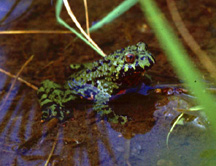 |
Robert H. KaplanProfessor of Biology, Emeritus.Appointments welcome via e-mail. Biology Building, room B212 |
Robert H. Kaplan
Professor of Biology, Emeritus.
Appointments welcome via e-mail.
Biology Building, room B212
tel. 503-517-7877
e-mail: Robert.Kaplan@reed.edu
The Carnegie Foundation U. S. Baccalaureate Colleges Professor of the Year 1996/97
EDUCATION | RESEARCH | TEACHING | MISCELLANEOUS |
| B.S., Brooklyn College, 1970 | |
| Ph.D., City University of New York, 1978 | |
| Miller Postdoctoral Fellowship, The Miller Institute for Basic Research in Science, University of California, Berkeley, 1978-80 |
Evolution and ecology of maternal effects and developmental plasticity in amphibians. | |
 For the past 12 years my laboratory has focused on the ecology, genetics, and development of the Asian fire-bellied toad, Bombina orientalis. For the past 12 years my laboratory has focused on the ecology, genetics, and development of the Asian fire-bellied toad, Bombina orientalis.
 This species has become an outstanding "model organism" for studies in embryology and ecology because it can be bred in the laboratory every 10 weeks, (unlike the yearly cycles of local amphibians), it is long lived (over 10 years in the laboratory), and it is accessible in the field.
In addition, these properties make it a fine research organism in an undergraduate environment. (Groups of students and myself have been spending summers in the field in the Republic of Korea since 1985.)
This species has become an outstanding "model organism" for studies in embryology and ecology because it can be bred in the laboratory every 10 weeks, (unlike the yearly cycles of local amphibians), it is long lived (over 10 years in the laboratory), and it is accessible in the field.
In addition, these properties make it a fine research organism in an undergraduate environment. (Groups of students and myself have been spending summers in the field in the Republic of Korea since 1985.)
 The basic question that I am interested in is how do environmental and genetic factors influence a female's reproduction to affect the quality of the offspring that she produces? Much data has accumulated in recent years that shows that
differences in maternal investment can ramify throughout larval life.
The overall goal of this research is to gain a better understanding of how an embryo is able to compensate for environmental uncertainty given that its mother was subjected to a variety of uncertain environmental influences at the time when eggs were forming in her body. The basic question that I am interested in is how do environmental and genetic factors influence a female's reproduction to affect the quality of the offspring that she produces? Much data has accumulated in recent years that shows that
differences in maternal investment can ramify throughout larval life.
The overall goal of this research is to gain a better understanding of how an embryo is able to compensate for environmental uncertainty given that its mother was subjected to a variety of uncertain environmental influences at the time when eggs were forming in her body.
| |
 We then took the experiment back to the field to evaluate locomotor performance under natural conditions. The consequences of egg size variation for morphology and sprint speed of hatchling larvae of Bombina were examined. This field study generated a data matrix consisting of individual sprint speeds, developmental rates, and predation survival rates for 940 individual larvae as well as photographs of each larva. At this point each of the larva in the photographs needs to be measured for 5 morphological characters (4,700 measurements). These data will be combined with the field data to generate the most complete data set to have ever been accumulated on this problem. We then took the experiment back to the field to evaluate locomotor performance under natural conditions. The consequences of egg size variation for morphology and sprint speed of hatchling larvae of Bombina were examined. This field study generated a data matrix consisting of individual sprint speeds, developmental rates, and predation survival rates for 940 individual larvae as well as photographs of each larva. At this point each of the larva in the photographs needs to be measured for 5 morphological characters (4,700 measurements). These data will be combined with the field data to generate the most complete data set to have ever been accumulated on this problem.
|
| Bio 101 - Introductory Biology | - This is a team taught, full unit course taught each year. | |
| Bio 366 - Population Biology: Ecology and Evolution | - This is a full unit course with a lecture and a laboratory. It is offered once each year. | |
| Bio 431 - Conservation Biology | - This is a half unit upper division seminar course and is offered every other year. | |
| Bio 431 - Field Biology and Natural History of Amphibians |
| Park Daesik, Min Mi-Sook, Lasater Kelly C., Song Jae-Young, Suh Jae-Hwa, Son Sang-Ho and Kaplan Robert H. (2014). Conservation of amphibians in South Korea. In, I. Das, M. Wilkinson, and H.Heatwole (eds.). Amphibian Biology, vol. 11, Conservation of Amphibians of the Eastern Hemisphere, pgs. 52-88. |
|
| Arrighi, J., E. Lencer. A. Jukar, D. Park, P. Phillips, and R. Kaplan (2013). Daily temperature fluctuations unpredictably influence developmental rate and morphology at a critical early larval stage in a frog. BMC Ecology 13:18. | |
| Lewis, Z. R.*, M. C. McClellan, J. H. Postlethwait, W. A. Cresko, and R. H. Kaplan (2008). Female-specific increase in primordial germ cells marks sex differentiation in threespine stickleback (Gasterosteus aculeatus). Journal of Morphology 269:909-921. | |
| Kaplan, R. H. and P.C. Phillips (2006). Ecological and developmental context of natural selection: maternal effects and thermally induced plasticity in the frog Bombina orientalis. Evolution 60:142-156. (pdf) | |
| Kaplan, R. H. (1998). Maternal effects, developmental plasticity, and life history evolution: an amphibian model. In T. A. Mousseau and C. W. Fox (eds.), Maternal Effects as Adaptations. Pp. 244 - 260. Oxford University Press, New York. | |
| Nijhuis, M. J.* and R. H. Kaplan (1998). Movement patterns and life history characteristics in a population of the cascade torrent salamander (Rhyacotriton cascadae) in the Columbia River Gorge, Oregon. Journal of Herpetology 32:301-304. | |
| King, E. G.* and R. H. Kaplan (1997). Estimating ovum size in amphibians: egg size increases differently among species during early development. J. Herpetol. 31:299-302. | |
| Kaplan, R. H. and E. G. King* (1997). Egg size is a developmentally plastic trait: evidence from long term studies in the frog, Bombina orientalis. Herpetologica 53:149 - 165. | |
| Parichy, D. M.* and R. H. Kaplan (1995). Maternal investment and developmental plasticity: functional consequences for locomotor performance on hatchling frog larvae. Functional Ecology 9:606-617. | |
| Parichy, D. M.* and R. H. Kaplan (1992). Maternal effects on offspring growth and development depend on environmental quality in the frog Bombina orientalis. Oecologia 91:579-586. | |
| Kaplan, R. H. (1992). Maternal investment in tadpoles and the probability of surviving predation in a thermally heterogeneous environment. Ecology 73:280-288. | |
| Parichy, D. M.* and R. H. Kaplan (1992). Developmental consequences of tail injury on larvae of the oriental fire-bellied toad, Bombina orientalis. Copeia 1992:129-137. | |
| Kaplan, R. H. (1991). Developmental plasticity and maternal effects in amphibian life histories. Proc. IVth Inter. Cong. Syst. Evol. The Unity of Evolutionary Biology, pp. 794-799. | |
| Marshall, C. J.*, L. S. Doyle, and R. H. Kaplan (1990). Intraspecific and sex-specific oophagy in a salamander and a frog: reproductive convergence of Taricha torosa and Bombina orientalis. Herpetologica 46:395-399. | |
| Kaplan, R. H. (1989). Ovum size plasticity and maternal effects on the early development of the frog, Bombina orientalis, in a field population in Korea. Functional Ecology 3:597-604. |
| For an essay on the relationship between creationism and science education published in the Reed Quarterly, February 1997 go to: Creationism: How dangerous is the attack on science by religious fundamentalists? |

Maintained by the Reed College Biology Department
Last Modified 02/11/06
Questions/Comments to Robert.Kaplan@directory.reed.edu